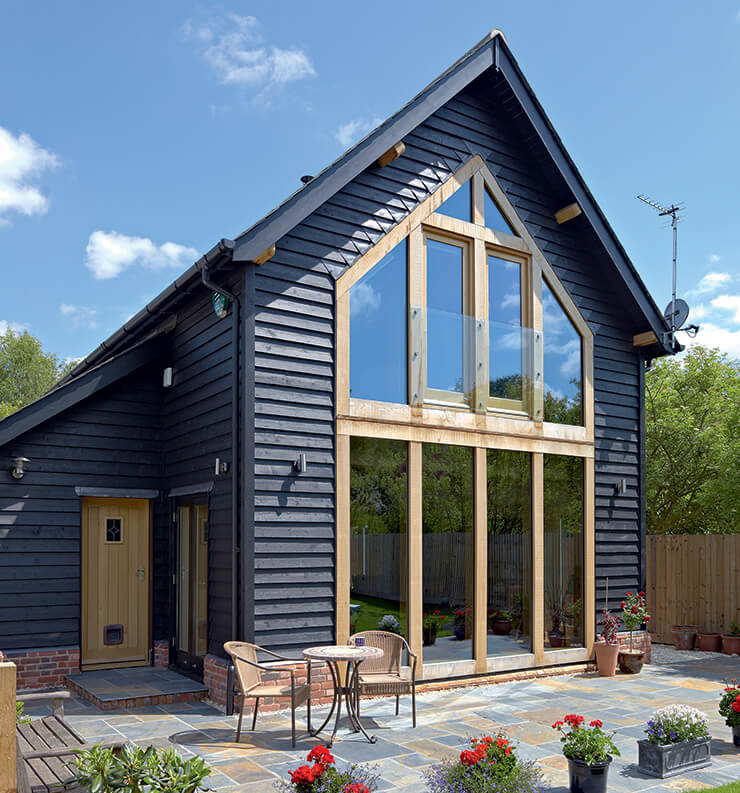
Early Bird Offer! Free tickets to meet independent experts at this summer's Build It Live
Save £24 - Book Now!
Early Bird Offer! Free tickets to meet independent experts at this summer's Build It Live
Save £24 - Book Now!Oak frame remains ever-popular among self-builders, thanks to its warm aesthetic and ability to add instant character. Traditionally, the timber is crafted while it’s still green – slotted together with tenon and mortise joints and secured with wooden pegs.
The material has been used in this way for over 4,000 years in Britain, perhaps most famously in Tudor- and barn-style builds. Yet it is increasingly employed in more contemporary schemes, too, with several companies pushing its technical boundaries in new and exciting ways – to stunning effect.
Many self builders see oak framing as a luxury option, but you might be surprised this route isn’t out of reach if you’re on a modest budget.
Final costs per m2 may typically be around 5%-10% higher than a softwood alternative but this is usually reflected in the value of your project. “We generally advise clients budget between £1,500 to £2,000 per m2 of usable floor space as a total build cost, excluding the plot and landscaping,” says Gareth Edmunds from Welsh Oak Frame.
There are also several clever ways you can keep prices down and still achieve the oak frame home of your dreams. Here’s how to make the most of your oak frame budget:
If you’re working with a tight budget, it’s vital that you approach all aspects of the scheme with this in mind. It’s easy to get carried away when you see what’s been achieved by those with deeper pockets – such as wide spans, feature trusses and glazed gables – but it’s best to stay disciplined and look for other ways to create wow factor.
“You can still add architectural interest with oak porches (ours start at just under £1,000), dormer windows, or other simple design features,” says Merry Albright from Border Oak.
The most cost-efficient schemes will use the simple rectangular bay floorplan commonly seen in cottage and barn-style projects. Despite this pared-back approach the result will still please the eye. “When you are building with a structural oak frame, by the very nature of the product you will get all the character you could wish for, even when making cost savings,” says Oakwrights’ David Grey.
What’s more, as the oak frame bears the weight of the building, there’s no need for load-bearing internal partition walls – allowing you to easily open up your living areas and create a sense of light and space.
Essential Advice: Building an Oak Frame Home: a Self Builder’s Complete Guide

This 213m2 (including an integrated 17m2 garage) one-and-a-half-storey dwelling from Welsh Oak Frame features a simple traditional design, modest glazing and selective use of oak. It was completed in 2011 at a cost of just £165,000 (£775 per m2). A similar project today would come in at around £195,000
As with any building method, the number of storeys will have an impact on costs. Generally, a single storey project with the same footprint as a multi-storey house will be cheaper overall, but more expensive per m2 of usable floorspace. Switching to one-and-a-half or two-storeys will mean paying more, but you’ll be making better use of the plot and extracting more value from the finished result.
“When compared to a single storey, adding a second is likely to raise expenditure by less than a third but significantly increases your usable space,” says Jamie Wilson, sales and marketing manager at Carpenter Oak.
One of the key reasons oak homes tend to cost more is that self-builders look to match the highly crafted frames with good quality products, such as handmade bricks and roof tiles. These can be sound purchases, recouped in the house’s value, but if you want luxury you can expect a price tag to match – likely £1,800+ per m2 for the final property.
It’s impossible to deny the impressive visual appeal of a large vaulted ceiling formed from a curved cruck frame, but this approach utilises additional oak compared to other routes. Opting for a more modest style will go a long way to making a scheme budget-friendly.
EXPERT VIEWGareth Edmunds from Welsh Oak Frame gives his top tips on how to get maximum wow at minimum cost: The beauty of an oak frame is that, by nature of the product, you’re guaranteed a characterful home, regardless of the scale or size. There are several ways you can keep costs down while still achieving the wow factor. The higher the volume of oak, the higher the cost. Traditional styles generally require the most amount of oak, exposed both internally and externally. Barn styles tend to have a simple footprint and are usually more open plan, with less oak exposed. Post and beam layouts work on a simple grid system and require even less oak. Complexity of design has a large impact on costs. It’s easy to get carried away when you see what can be achieved with an oak frame, such as wide spans, feature trusses and glazed gables. But there are numerous cost-effective ways to create the wow factor. So, work with a designer experienced in oak frame, who can advise on how to make the most of your budget. The main focal or gathering points are key areas to show off oak frame features – for instance, a hallway could feature a vaulted ceiling. You could then save money by switching to conventional build methods for the less important rooms. Gareth Edmunds is a director at Welsh Oak Frame, having worked with the company for 14 years as a designer. Gareth has extensive knowledge of oak framing, designing homes that deliver practically and aesthetically within client budgets. |
“A basic post and beam house allows decent scope for attractive designs but at a minimal outlay for materials,” says Mark Jones from Welsh Oak Frame. “We have experienced clients achieving build costs as low as £1,200 per m2 using this method.”
You’ll often see large areas of glass applied to oak frame projects through a process known as face glazing – usually either at a gable end or on part of one of the main elevations. This is a robust way of letting in ample natural light and is a striking architectural feature. However, for those schemes where money is tight, more traditional fenestration could be a wiser use of funds.
“Depending on the style of the building, there are different ways of incorporating glazing,” says David. “Windows and doors can be fitted into the walling system as standard joinery elements. Oakwrights do this in their workshop to maintain high standards of quality control and good building practice.”
It may be tempting to splash out on a designer kitchen but interior features such as this are relatively simple to upgrade in the future. A limited budget is best spent on the structure itself as this is central to a successful scheme and much harder to alter further down the line.
“Reducing the spec of the oak frame in your design won’t really make a meaningful difference if you then commission bespoke handmade oak doors, expensive flooring, fancy bathrooms and every tech gadget you can think of,” says Merry.

By employing structural SIPs and a rectangular design, Carpenter Oak were able to complete this stunning 186m2 home for £265,000 (£1,425 per m2), excluding the external landscaping
Many oak frame companies are capable of overseeing a scheme right up to its completion, and their experience and connections can be instrumental in ensuring your self-build is a success – not to mention their bulk-buying power. A turnkey or main contractor route gives you the security of a fixed price and professional expertise, so it’s a great option for first timers, but you will usually pay extra for the privilege.
A common alternative is to have them hand over the reins partway through. “Opting for a supplied and erected oak frame with an insulated wall and roofing encapsulation system effectively gives you a watertight shell to work with,” says David from Oakwrights.
If you have the time and organisational ability you will find that there are savings to be made by sourcing products and follow-on trades yourself. “Project managing will definitely be a cost effective option for some and we are always delighted to help self-builders who want to take this route – but we also urge them to be realistic with their scheduling” says Merry.

This beautiful oak frame home by Oakwrights proves that an attractive property can be achieved on a low cost budget
You don’t necessarily have to enclose the frame to make it budget-friendly but doing so can lessen the need for weight-bearing, relatively expensive oak. This can be the case if the partner panel system takes on a structural role, reducing the specification elsewhere.
“Softwood panels are generally the least expensive method here, but it is not normally a big enough saving to rule out other options completely,” says Merry. “Using structural insulated panels (SIPs) tends to work out more expensive, but it is high performance, pre-insulated and quick to build.”
When it comes to cladding, wood products often offer the best bang for your buck. “Larch is frequently recommended for its effect and cost,” says Jamie. “As a substitute to a natural wood finish, you may wish to consider Cape Cod cladding. It can be delivered fully painted.”
Alternatively, those comfortable getting hands on with bricks and mortar may find the labour savings tip the scales in its favour as a budget-friendly exterior finish.
The hybrid alternativeIf you’re looking to cut costs even further, you could opt for a hybrid approach to your timber frame – using softwood for the primary structural elements and reserving oak for those high-impact areas. Here’s what to consider:
|
If you’re willing and able, consider rolling up your sleeves and cleaning the oak yourself. This could save you in the region of £1,500 to £4,000, depending on the size and complexity of your project. It’s a monotonous and time consuming process but that’s precisely why it can help you keep under-budget.
Many self-builders prefer to maintain the organic colour and character of the wood with a simple acid wash, leaving the wood’s own tannins to prevent damage from moisture and insects. “We always encourage clients to use the oxalic treatment for cleaning the oak,” says Mark. “It’s so simple but has a tremendous effect. We are not particularly keen on sand blasted finishes and power sanding would be a never-ending task.”
You can even leave the timber completely untreated and let the craftsmanship shine through. “One option is to keep the frame in its natural finish, including the marks left by the carpenters, representing the journey the oak has gone through to make your home,” says Jamie.
Closer look: An oak frame cottage
The gable ends, often the most expensive part of an oak frame, were built from softwood and faced in brick. In the same vein, the owners decided to add a secondary weatherboard-clad section to one side, completed without the use of oak. Elsewhere, the simple post and beam system further reduced material expenses and the first storey occupies part of the roof. The total build cost was £230,000 (£1,420 per m2). |
This feature was first written in 2017, and was updated on 2nd February 2021

